Strategic Change Management and Leadership at Royal Dutch Shell
VerifiedAdded on 2020/01/07
|31
|9998
|2009
Report
AI Summary
This report provides an in-depth analysis of change management and strategic leadership within Royal Dutch Shell. It begins by defining key concepts and then explores the impact of classical and contemporary management and leadership styles on change initiatives. The report examines various leadership styles, including autocratic, democratic, laissez-faire, charismatic, and bureaucratic, as well as contemporary theories such as transformational, transactional, trait, and contingency theories, and how they apply to Shell's operations. The report also addresses internal and external triggers for change, stakeholder analysis, and the impact of current management and leadership styles on planned change management functions. Finally, it discusses the contribution of HRM practices to the success of Shell's performance management process. The report aims to provide a comprehensive understanding of the challenges and opportunities related to change management within a multinational oil and gas company like Royal Dutch Shell.
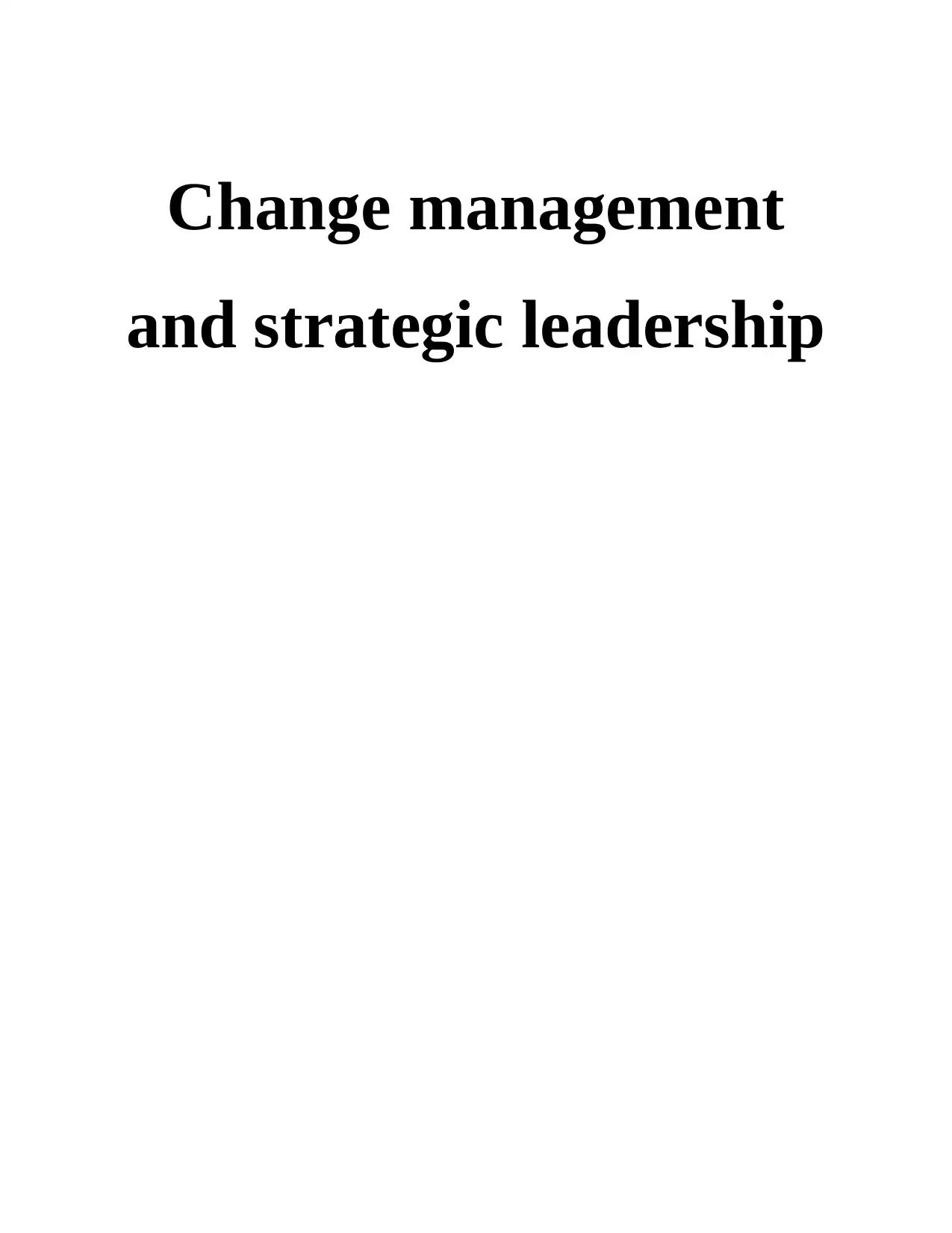
Change management
and strategic leadership
and strategic leadership
Paraphrase This Document
Need a fresh take? Get an instant paraphrase of this document with our AI Paraphraser
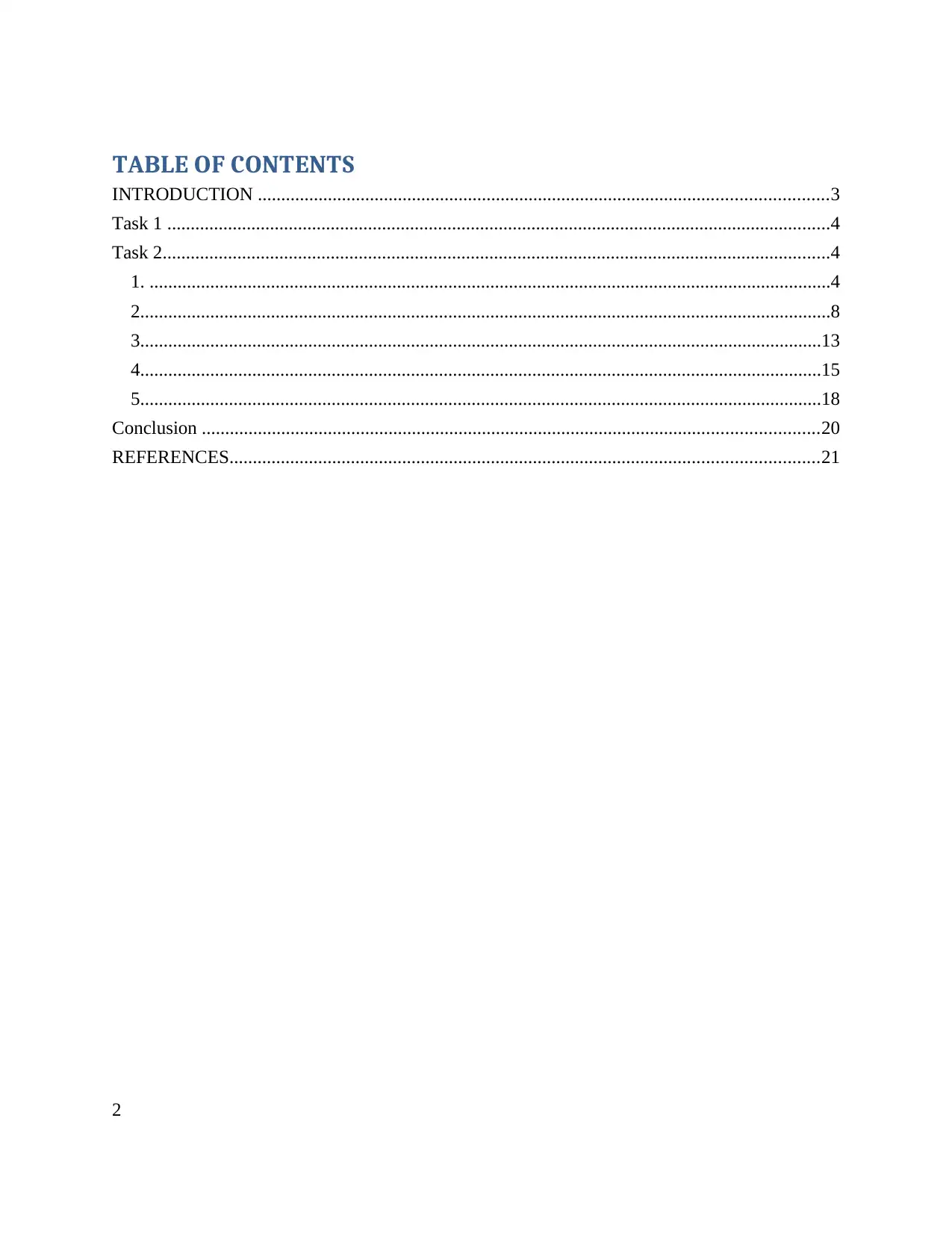
TABLE OF CONTENTS
INTRODUCTION ..........................................................................................................................3
Task 1 ..............................................................................................................................................4
Task 2...............................................................................................................................................4
1. ..................................................................................................................................................4
2....................................................................................................................................................8
3..................................................................................................................................................13
4..................................................................................................................................................15
5..................................................................................................................................................18
Conclusion ....................................................................................................................................20
REFERENCES..............................................................................................................................21
2
INTRODUCTION ..........................................................................................................................3
Task 1 ..............................................................................................................................................4
Task 2...............................................................................................................................................4
1. ..................................................................................................................................................4
2....................................................................................................................................................8
3..................................................................................................................................................13
4..................................................................................................................................................15
5..................................................................................................................................................18
Conclusion ....................................................................................................................................20
REFERENCES..............................................................................................................................21
2
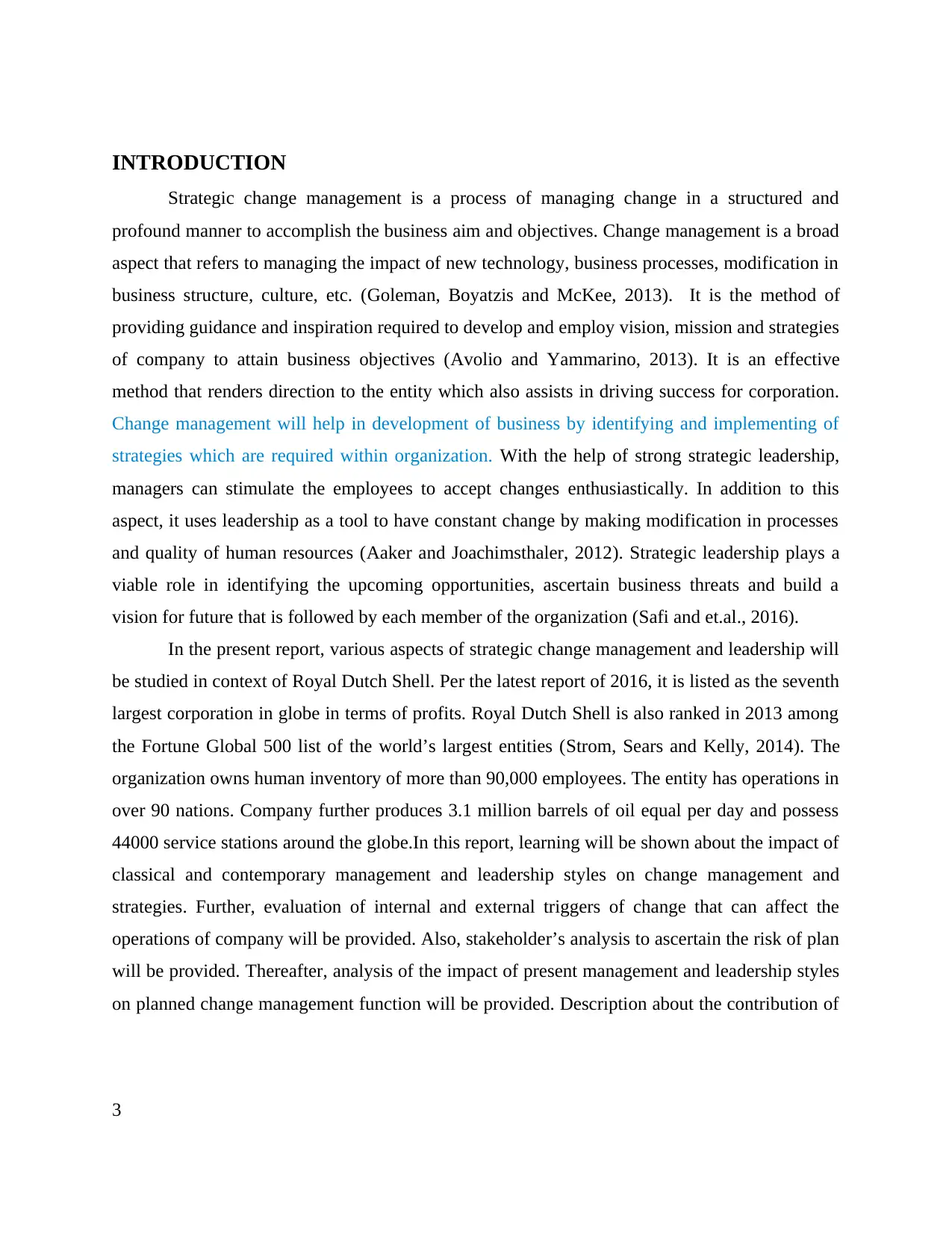
INTRODUCTION
Strategic change management is a process of managing change in a structured and
profound manner to accomplish the business aim and objectives. Change management is a broad
aspect that refers to managing the impact of new technology, business processes, modification in
business structure, culture, etc. (Goleman, Boyatzis and McKee, 2013). It is the method of
providing guidance and inspiration required to develop and employ vision, mission and strategies
of company to attain business objectives (Avolio and Yammarino, 2013). It is an effective
method that renders direction to the entity which also assists in driving success for corporation.
Change management will help in development of business by identifying and implementing of
strategies which are required within organization. With the help of strong strategic leadership,
managers can stimulate the employees to accept changes enthusiastically. In addition to this
aspect, it uses leadership as a tool to have constant change by making modification in processes
and quality of human resources (Aaker and Joachimsthaler, 2012). Strategic leadership plays a
viable role in identifying the upcoming opportunities, ascertain business threats and build a
vision for future that is followed by each member of the organization (Safi and et.al., 2016).
In the present report, various aspects of strategic change management and leadership will
be studied in context of Royal Dutch Shell. Per the latest report of 2016, it is listed as the seventh
largest corporation in globe in terms of profits. Royal Dutch Shell is also ranked in 2013 among
the Fortune Global 500 list of the world’s largest entities (Strom, Sears and Kelly, 2014). The
organization owns human inventory of more than 90,000 employees. The entity has operations in
over 90 nations. Company further produces 3.1 million barrels of oil equal per day and possess
44000 service stations around the globe.In this report, learning will be shown about the impact of
classical and contemporary management and leadership styles on change management and
strategies. Further, evaluation of internal and external triggers of change that can affect the
operations of company will be provided. Also, stakeholder’s analysis to ascertain the risk of plan
will be provided. Thereafter, analysis of the impact of present management and leadership styles
on planned change management function will be provided. Description about the contribution of
3
Strategic change management is a process of managing change in a structured and
profound manner to accomplish the business aim and objectives. Change management is a broad
aspect that refers to managing the impact of new technology, business processes, modification in
business structure, culture, etc. (Goleman, Boyatzis and McKee, 2013). It is the method of
providing guidance and inspiration required to develop and employ vision, mission and strategies
of company to attain business objectives (Avolio and Yammarino, 2013). It is an effective
method that renders direction to the entity which also assists in driving success for corporation.
Change management will help in development of business by identifying and implementing of
strategies which are required within organization. With the help of strong strategic leadership,
managers can stimulate the employees to accept changes enthusiastically. In addition to this
aspect, it uses leadership as a tool to have constant change by making modification in processes
and quality of human resources (Aaker and Joachimsthaler, 2012). Strategic leadership plays a
viable role in identifying the upcoming opportunities, ascertain business threats and build a
vision for future that is followed by each member of the organization (Safi and et.al., 2016).
In the present report, various aspects of strategic change management and leadership will
be studied in context of Royal Dutch Shell. Per the latest report of 2016, it is listed as the seventh
largest corporation in globe in terms of profits. Royal Dutch Shell is also ranked in 2013 among
the Fortune Global 500 list of the world’s largest entities (Strom, Sears and Kelly, 2014). The
organization owns human inventory of more than 90,000 employees. The entity has operations in
over 90 nations. Company further produces 3.1 million barrels of oil equal per day and possess
44000 service stations around the globe.In this report, learning will be shown about the impact of
classical and contemporary management and leadership styles on change management and
strategies. Further, evaluation of internal and external triggers of change that can affect the
operations of company will be provided. Also, stakeholder’s analysis to ascertain the risk of plan
will be provided. Thereafter, analysis of the impact of present management and leadership styles
on planned change management function will be provided. Description about the contribution of
3
⊘ This is a preview!⊘
Do you want full access?
Subscribe today to unlock all pages.

Trusted by 1+ million students worldwide
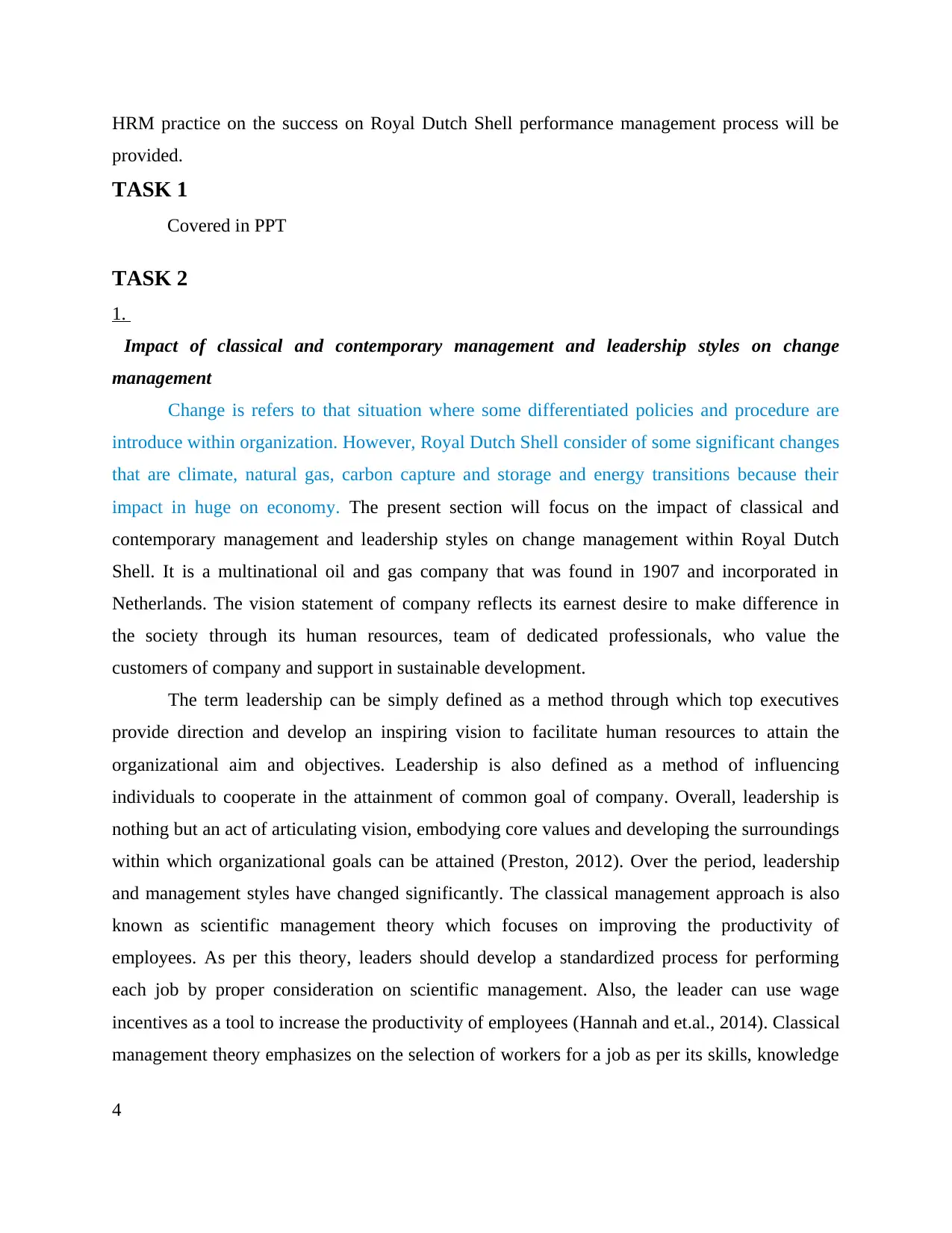
HRM practice on the success on Royal Dutch Shell performance management process will be
provided.
TASK 1
Covered in PPT
TASK 2
1.
Impact of classical and contemporary management and leadership styles on change
management
Change is refers to that situation where some differentiated policies and procedure are
introduce within organization. However, Royal Dutch Shell consider of some significant changes
that are climate, natural gas, carbon capture and storage and energy transitions because their
impact in huge on economy. The present section will focus on the impact of classical and
contemporary management and leadership styles on change management within Royal Dutch
Shell. It is a multinational oil and gas company that was found in 1907 and incorporated in
Netherlands. The vision statement of company reflects its earnest desire to make difference in
the society through its human resources, team of dedicated professionals, who value the
customers of company and support in sustainable development.
The term leadership can be simply defined as a method through which top executives
provide direction and develop an inspiring vision to facilitate human resources to attain the
organizational aim and objectives. Leadership is also defined as a method of influencing
individuals to cooperate in the attainment of common goal of company. Overall, leadership is
nothing but an act of articulating vision, embodying core values and developing the surroundings
within which organizational goals can be attained (Preston, 2012). Over the period, leadership
and management styles have changed significantly. The classical management approach is also
known as scientific management theory which focuses on improving the productivity of
employees. As per this theory, leaders should develop a standardized process for performing
each job by proper consideration on scientific management. Also, the leader can use wage
incentives as a tool to increase the productivity of employees (Hannah and et.al., 2014). Classical
management theory emphasizes on the selection of workers for a job as per its skills, knowledge
4
provided.
TASK 1
Covered in PPT
TASK 2
1.
Impact of classical and contemporary management and leadership styles on change
management
Change is refers to that situation where some differentiated policies and procedure are
introduce within organization. However, Royal Dutch Shell consider of some significant changes
that are climate, natural gas, carbon capture and storage and energy transitions because their
impact in huge on economy. The present section will focus on the impact of classical and
contemporary management and leadership styles on change management within Royal Dutch
Shell. It is a multinational oil and gas company that was found in 1907 and incorporated in
Netherlands. The vision statement of company reflects its earnest desire to make difference in
the society through its human resources, team of dedicated professionals, who value the
customers of company and support in sustainable development.
The term leadership can be simply defined as a method through which top executives
provide direction and develop an inspiring vision to facilitate human resources to attain the
organizational aim and objectives. Leadership is also defined as a method of influencing
individuals to cooperate in the attainment of common goal of company. Overall, leadership is
nothing but an act of articulating vision, embodying core values and developing the surroundings
within which organizational goals can be attained (Preston, 2012). Over the period, leadership
and management styles have changed significantly. The classical management approach is also
known as scientific management theory which focuses on improving the productivity of
employees. As per this theory, leaders should develop a standardized process for performing
each job by proper consideration on scientific management. Also, the leader can use wage
incentives as a tool to increase the productivity of employees (Hannah and et.al., 2014). Classical
management theory emphasizes on the selection of workers for a job as per its skills, knowledge
4
Paraphrase This Document
Need a fresh take? Get an instant paraphrase of this document with our AI Paraphraser
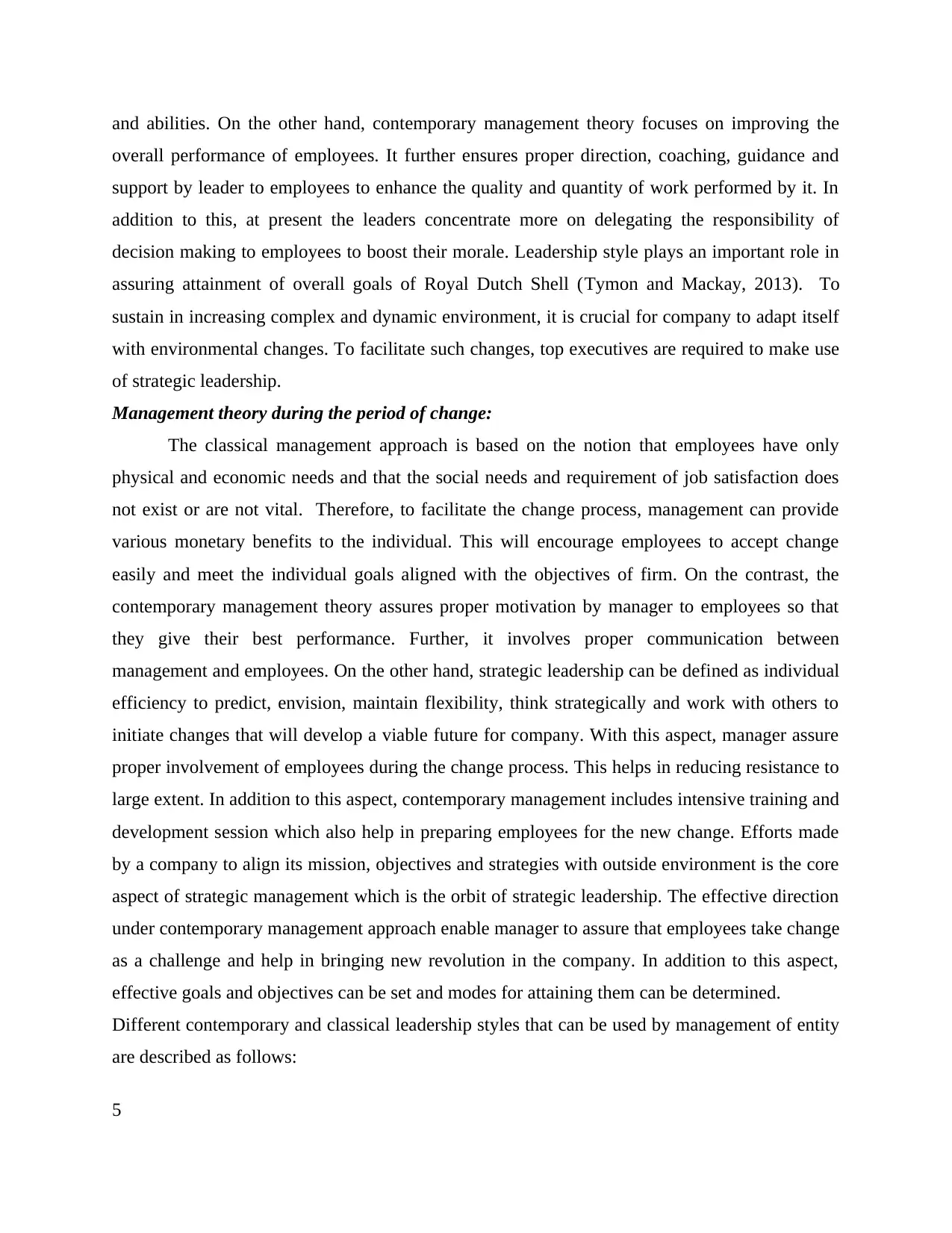
and abilities. On the other hand, contemporary management theory focuses on improving the
overall performance of employees. It further ensures proper direction, coaching, guidance and
support by leader to employees to enhance the quality and quantity of work performed by it. In
addition to this, at present the leaders concentrate more on delegating the responsibility of
decision making to employees to boost their morale. Leadership style plays an important role in
assuring attainment of overall goals of Royal Dutch Shell (Tymon and Mackay, 2013). To
sustain in increasing complex and dynamic environment, it is crucial for company to adapt itself
with environmental changes. To facilitate such changes, top executives are required to make use
of strategic leadership.
Management theory during the period of change:
The classical management approach is based on the notion that employees have only
physical and economic needs and that the social needs and requirement of job satisfaction does
not exist or are not vital. Therefore, to facilitate the change process, management can provide
various monetary benefits to the individual. This will encourage employees to accept change
easily and meet the individual goals aligned with the objectives of firm. On the contrast, the
contemporary management theory assures proper motivation by manager to employees so that
they give their best performance. Further, it involves proper communication between
management and employees. On the other hand, strategic leadership can be defined as individual
efficiency to predict, envision, maintain flexibility, think strategically and work with others to
initiate changes that will develop a viable future for company. With this aspect, manager assure
proper involvement of employees during the change process. This helps in reducing resistance to
large extent. In addition to this aspect, contemporary management includes intensive training and
development session which also help in preparing employees for the new change. Efforts made
by a company to align its mission, objectives and strategies with outside environment is the core
aspect of strategic management which is the orbit of strategic leadership. The effective direction
under contemporary management approach enable manager to assure that employees take change
as a challenge and help in bringing new revolution in the company. In addition to this aspect,
effective goals and objectives can be set and modes for attaining them can be determined.
Different contemporary and classical leadership styles that can be used by management of entity
are described as follows:
5
overall performance of employees. It further ensures proper direction, coaching, guidance and
support by leader to employees to enhance the quality and quantity of work performed by it. In
addition to this, at present the leaders concentrate more on delegating the responsibility of
decision making to employees to boost their morale. Leadership style plays an important role in
assuring attainment of overall goals of Royal Dutch Shell (Tymon and Mackay, 2013). To
sustain in increasing complex and dynamic environment, it is crucial for company to adapt itself
with environmental changes. To facilitate such changes, top executives are required to make use
of strategic leadership.
Management theory during the period of change:
The classical management approach is based on the notion that employees have only
physical and economic needs and that the social needs and requirement of job satisfaction does
not exist or are not vital. Therefore, to facilitate the change process, management can provide
various monetary benefits to the individual. This will encourage employees to accept change
easily and meet the individual goals aligned with the objectives of firm. On the contrast, the
contemporary management theory assures proper motivation by manager to employees so that
they give their best performance. Further, it involves proper communication between
management and employees. On the other hand, strategic leadership can be defined as individual
efficiency to predict, envision, maintain flexibility, think strategically and work with others to
initiate changes that will develop a viable future for company. With this aspect, manager assure
proper involvement of employees during the change process. This helps in reducing resistance to
large extent. In addition to this aspect, contemporary management includes intensive training and
development session which also help in preparing employees for the new change. Efforts made
by a company to align its mission, objectives and strategies with outside environment is the core
aspect of strategic management which is the orbit of strategic leadership. The effective direction
under contemporary management approach enable manager to assure that employees take change
as a challenge and help in bringing new revolution in the company. In addition to this aspect,
effective goals and objectives can be set and modes for attaining them can be determined.
Different contemporary and classical leadership styles that can be used by management of entity
are described as follows:
5
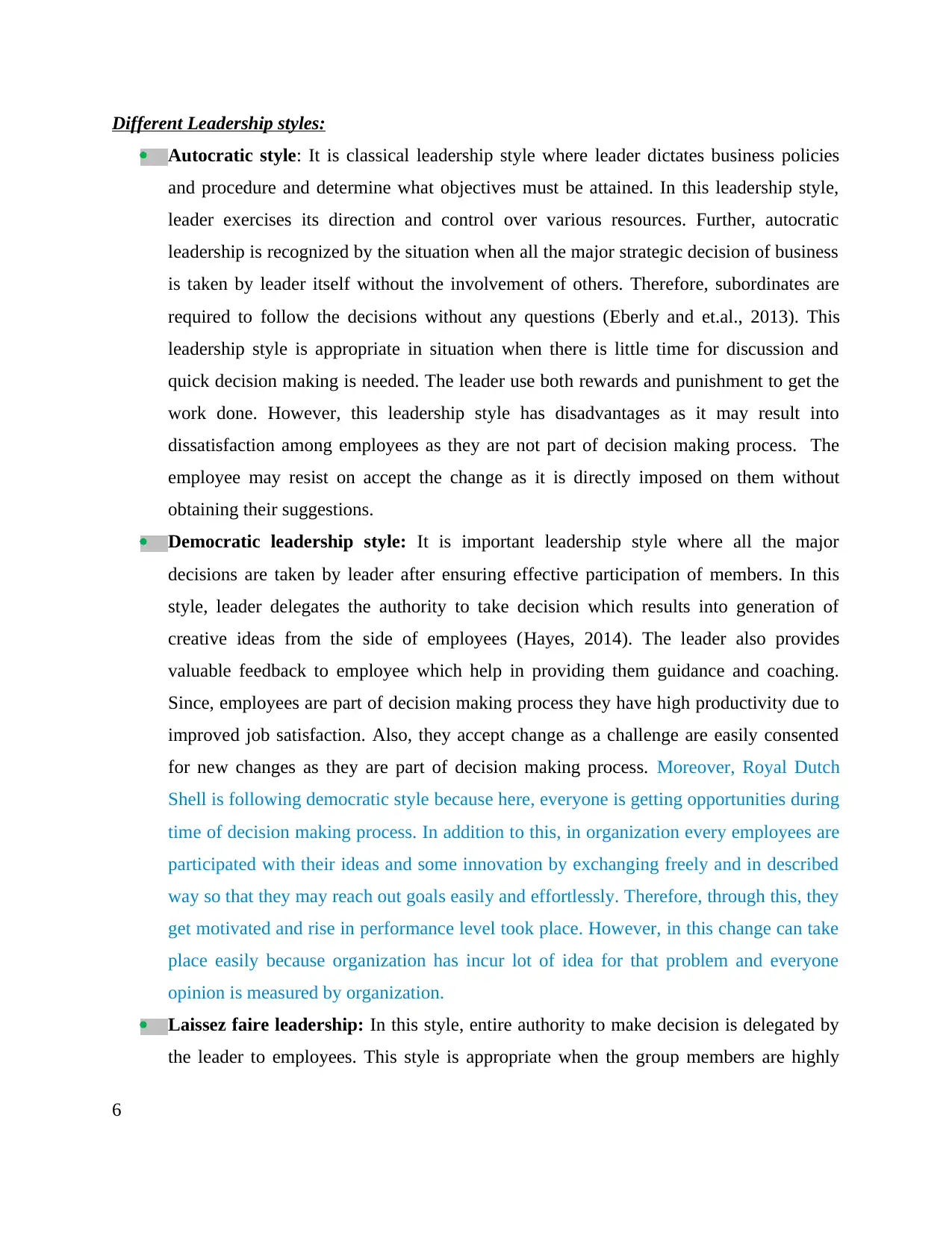
Different Leadership styles:
Autocratic style: It is classical leadership style where leader dictates business policies
and procedure and determine what objectives must be attained. In this leadership style,
leader exercises its direction and control over various resources. Further, autocratic
leadership is recognized by the situation when all the major strategic decision of business
is taken by leader itself without the involvement of others. Therefore, subordinates are
required to follow the decisions without any questions (Eberly and et.al., 2013). This
leadership style is appropriate in situation when there is little time for discussion and
quick decision making is needed. The leader use both rewards and punishment to get the
work done. However, this leadership style has disadvantages as it may result into
dissatisfaction among employees as they are not part of decision making process. The
employee may resist on accept the change as it is directly imposed on them without
obtaining their suggestions.
Democratic leadership style: It is important leadership style where all the major
decisions are taken by leader after ensuring effective participation of members. In this
style, leader delegates the authority to take decision which results into generation of
creative ideas from the side of employees (Hayes, 2014). The leader also provides
valuable feedback to employee which help in providing them guidance and coaching.
Since, employees are part of decision making process they have high productivity due to
improved job satisfaction. Also, they accept change as a challenge are easily consented
for new changes as they are part of decision making process. Moreover, Royal Dutch
Shell is following democratic style because here, everyone is getting opportunities during
time of decision making process. In addition to this, in organization every employees are
participated with their ideas and some innovation by exchanging freely and in described
way so that they may reach out goals easily and effortlessly. Therefore, through this, they
get motivated and rise in performance level took place. However, in this change can take
place easily because organization has incur lot of idea for that problem and everyone
opinion is measured by organization.
Laissez faire leadership: In this style, entire authority to make decision is delegated by
the leader to employees. This style is appropriate when the group members are highly
6
Autocratic style: It is classical leadership style where leader dictates business policies
and procedure and determine what objectives must be attained. In this leadership style,
leader exercises its direction and control over various resources. Further, autocratic
leadership is recognized by the situation when all the major strategic decision of business
is taken by leader itself without the involvement of others. Therefore, subordinates are
required to follow the decisions without any questions (Eberly and et.al., 2013). This
leadership style is appropriate in situation when there is little time for discussion and
quick decision making is needed. The leader use both rewards and punishment to get the
work done. However, this leadership style has disadvantages as it may result into
dissatisfaction among employees as they are not part of decision making process. The
employee may resist on accept the change as it is directly imposed on them without
obtaining their suggestions.
Democratic leadership style: It is important leadership style where all the major
decisions are taken by leader after ensuring effective participation of members. In this
style, leader delegates the authority to take decision which results into generation of
creative ideas from the side of employees (Hayes, 2014). The leader also provides
valuable feedback to employee which help in providing them guidance and coaching.
Since, employees are part of decision making process they have high productivity due to
improved job satisfaction. Also, they accept change as a challenge are easily consented
for new changes as they are part of decision making process. Moreover, Royal Dutch
Shell is following democratic style because here, everyone is getting opportunities during
time of decision making process. In addition to this, in organization every employees are
participated with their ideas and some innovation by exchanging freely and in described
way so that they may reach out goals easily and effortlessly. Therefore, through this, they
get motivated and rise in performance level took place. However, in this change can take
place easily because organization has incur lot of idea for that problem and everyone
opinion is measured by organization.
Laissez faire leadership: In this style, entire authority to make decision is delegated by
the leader to employees. This style is appropriate when the group members are highly
6
⊘ This is a preview!⊘
Do you want full access?
Subscribe today to unlock all pages.

Trusted by 1+ million students worldwide
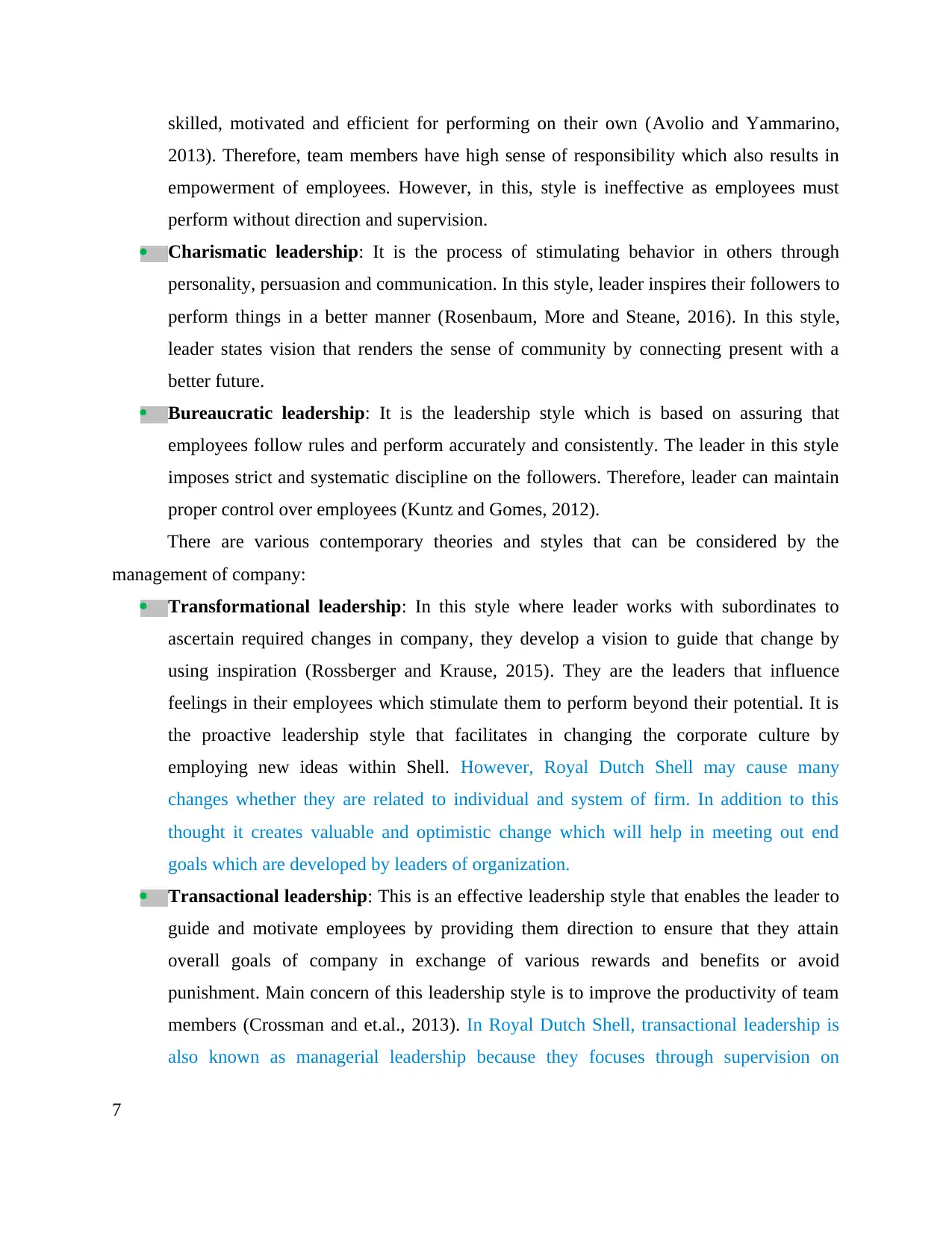
skilled, motivated and efficient for performing on their own (Avolio and Yammarino,
2013). Therefore, team members have high sense of responsibility which also results in
empowerment of employees. However, in this, style is ineffective as employees must
perform without direction and supervision.
Charismatic leadership: It is the process of stimulating behavior in others through
personality, persuasion and communication. In this style, leader inspires their followers to
perform things in a better manner (Rosenbaum, More and Steane, 2016). In this style,
leader states vision that renders the sense of community by connecting present with a
better future.
Bureaucratic leadership: It is the leadership style which is based on assuring that
employees follow rules and perform accurately and consistently. The leader in this style
imposes strict and systematic discipline on the followers. Therefore, leader can maintain
proper control over employees (Kuntz and Gomes, 2012).
There are various contemporary theories and styles that can be considered by the
management of company:
Transformational leadership: In this style where leader works with subordinates to
ascertain required changes in company, they develop a vision to guide that change by
using inspiration (Rossberger and Krause, 2015). They are the leaders that influence
feelings in their employees which stimulate them to perform beyond their potential. It is
the proactive leadership style that facilitates in changing the corporate culture by
employing new ideas within Shell. However, Royal Dutch Shell may cause many
changes whether they are related to individual and system of firm. In addition to this
thought it creates valuable and optimistic change which will help in meeting out end
goals which are developed by leaders of organization.
Transactional leadership: This is an effective leadership style that enables the leader to
guide and motivate employees by providing them direction to ensure that they attain
overall goals of company in exchange of various rewards and benefits or avoid
punishment. Main concern of this leadership style is to improve the productivity of team
members (Crossman and et.al., 2013). In Royal Dutch Shell, transactional leadership is
also known as managerial leadership because they focuses through supervision on
7
2013). Therefore, team members have high sense of responsibility which also results in
empowerment of employees. However, in this, style is ineffective as employees must
perform without direction and supervision.
Charismatic leadership: It is the process of stimulating behavior in others through
personality, persuasion and communication. In this style, leader inspires their followers to
perform things in a better manner (Rosenbaum, More and Steane, 2016). In this style,
leader states vision that renders the sense of community by connecting present with a
better future.
Bureaucratic leadership: It is the leadership style which is based on assuring that
employees follow rules and perform accurately and consistently. The leader in this style
imposes strict and systematic discipline on the followers. Therefore, leader can maintain
proper control over employees (Kuntz and Gomes, 2012).
There are various contemporary theories and styles that can be considered by the
management of company:
Transformational leadership: In this style where leader works with subordinates to
ascertain required changes in company, they develop a vision to guide that change by
using inspiration (Rossberger and Krause, 2015). They are the leaders that influence
feelings in their employees which stimulate them to perform beyond their potential. It is
the proactive leadership style that facilitates in changing the corporate culture by
employing new ideas within Shell. However, Royal Dutch Shell may cause many
changes whether they are related to individual and system of firm. In addition to this
thought it creates valuable and optimistic change which will help in meeting out end
goals which are developed by leaders of organization.
Transactional leadership: This is an effective leadership style that enables the leader to
guide and motivate employees by providing them direction to ensure that they attain
overall goals of company in exchange of various rewards and benefits or avoid
punishment. Main concern of this leadership style is to improve the productivity of team
members (Crossman and et.al., 2013). In Royal Dutch Shell, transactional leadership is
also known as managerial leadership because they focuses through supervision on
7
Paraphrase This Document
Need a fresh take? Get an instant paraphrase of this document with our AI Paraphraser
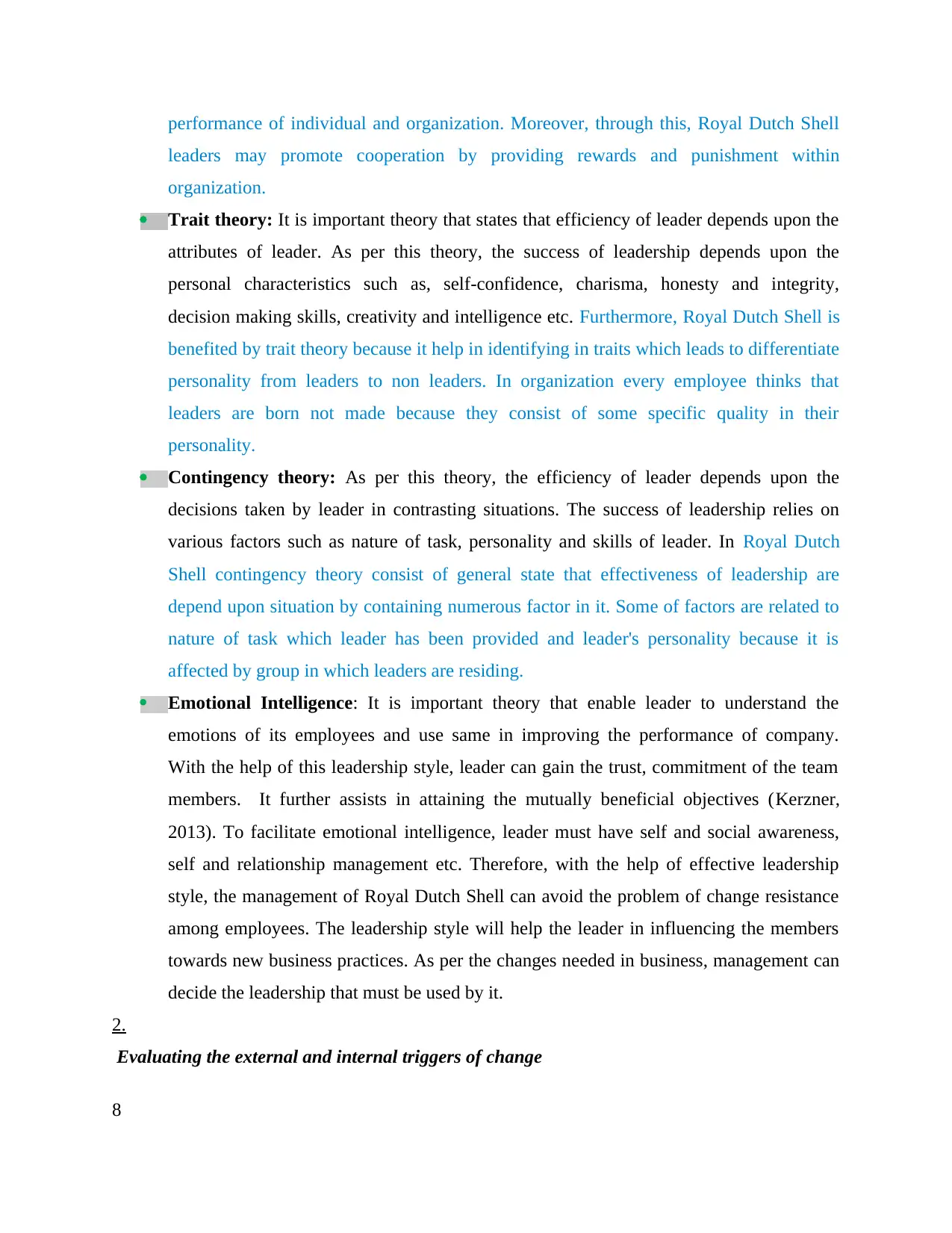
performance of individual and organization. Moreover, through this, Royal Dutch Shell
leaders may promote cooperation by providing rewards and punishment within
organization.
Trait theory: It is important theory that states that efficiency of leader depends upon the
attributes of leader. As per this theory, the success of leadership depends upon the
personal characteristics such as, self-confidence, charisma, honesty and integrity,
decision making skills, creativity and intelligence etc. Furthermore, Royal Dutch Shell is
benefited by trait theory because it help in identifying in traits which leads to differentiate
personality from leaders to non leaders. In organization every employee thinks that
leaders are born not made because they consist of some specific quality in their
personality.
Contingency theory: As per this theory, the efficiency of leader depends upon the
decisions taken by leader in contrasting situations. The success of leadership relies on
various factors such as nature of task, personality and skills of leader. In Royal Dutch
Shell contingency theory consist of general state that effectiveness of leadership are
depend upon situation by containing numerous factor in it. Some of factors are related to
nature of task which leader has been provided and leader's personality because it is
affected by group in which leaders are residing.
Emotional Intelligence: It is important theory that enable leader to understand the
emotions of its employees and use same in improving the performance of company.
With the help of this leadership style, leader can gain the trust, commitment of the team
members. It further assists in attaining the mutually beneficial objectives (Kerzner,
2013). To facilitate emotional intelligence, leader must have self and social awareness,
self and relationship management etc. Therefore, with the help of effective leadership
style, the management of Royal Dutch Shell can avoid the problem of change resistance
among employees. The leadership style will help the leader in influencing the members
towards new business practices. As per the changes needed in business, management can
decide the leadership that must be used by it.
2.
Evaluating the external and internal triggers of change
8
leaders may promote cooperation by providing rewards and punishment within
organization.
Trait theory: It is important theory that states that efficiency of leader depends upon the
attributes of leader. As per this theory, the success of leadership depends upon the
personal characteristics such as, self-confidence, charisma, honesty and integrity,
decision making skills, creativity and intelligence etc. Furthermore, Royal Dutch Shell is
benefited by trait theory because it help in identifying in traits which leads to differentiate
personality from leaders to non leaders. In organization every employee thinks that
leaders are born not made because they consist of some specific quality in their
personality.
Contingency theory: As per this theory, the efficiency of leader depends upon the
decisions taken by leader in contrasting situations. The success of leadership relies on
various factors such as nature of task, personality and skills of leader. In Royal Dutch
Shell contingency theory consist of general state that effectiveness of leadership are
depend upon situation by containing numerous factor in it. Some of factors are related to
nature of task which leader has been provided and leader's personality because it is
affected by group in which leaders are residing.
Emotional Intelligence: It is important theory that enable leader to understand the
emotions of its employees and use same in improving the performance of company.
With the help of this leadership style, leader can gain the trust, commitment of the team
members. It further assists in attaining the mutually beneficial objectives (Kerzner,
2013). To facilitate emotional intelligence, leader must have self and social awareness,
self and relationship management etc. Therefore, with the help of effective leadership
style, the management of Royal Dutch Shell can avoid the problem of change resistance
among employees. The leadership style will help the leader in influencing the members
towards new business practices. As per the changes needed in business, management can
decide the leadership that must be used by it.
2.
Evaluating the external and internal triggers of change
8

To sustain in present dynamic environment, it is important for company to assure
constant change. With this aspect, management can stay ahead of its rivals. The changes within
Royal Dutch Shell Company are driven by various internal and external factors. These triggers
further stimulate the entity to update its systems and processes (Sriram and et.al., 2013). They
are further described as follows:
External Triggers
PESTEL of Royal Dutch Shell is as described under:
Political factor: This factor main role is played by government because they form policies
and procedure related to industry and employees sake.
Government legislation: There are various policies and frameworks generated by
government that compel company to make modification in business practices. Such as, new
environmental laws regarding exploration of oil and restriction on limit the Shell Company from
performing various activities. The other government policies such as taxation can also impact
working style of company. Such as increase in taxation will compel company to change from
present costly methods to cheaper one.
Economic factor: This factor consist of Change in economy because modification in
economy constituents have direct impact on the performance of company. In this respect, change
in GDP, disposable income, bank rate, inflation rate, interest rate etc. At present bank rate in UK
is 0.5% which facilitate Shell Company to obtain loans at low rate (Lam, Huang and Chan,
2015). However, increase in this rate will make borrowings costly leading to loss of business or
stimulate entity to increase the prices of biofuels and petroleum. The organization may be force
to adopt cost effective technology to minimize operational cost.
Social factor: This factor includes of change in trend, custom, values, norms and belief.
Therefore, customer feedback can modifications in customer needs organization need to consider
all feedback from customer by considering preference may stimulate company to make necessary
changes in its products and services. In Royal Dutch Shell, enterprise need to evaluate all
feedback from their consumers because they are receiver of organization product such as, with
growing environment concern, Shell company is forced to take actions to reduce the negative
impact of oil extraction on environment.
9
constant change. With this aspect, management can stay ahead of its rivals. The changes within
Royal Dutch Shell Company are driven by various internal and external factors. These triggers
further stimulate the entity to update its systems and processes (Sriram and et.al., 2013). They
are further described as follows:
External Triggers
PESTEL of Royal Dutch Shell is as described under:
Political factor: This factor main role is played by government because they form policies
and procedure related to industry and employees sake.
Government legislation: There are various policies and frameworks generated by
government that compel company to make modification in business practices. Such as, new
environmental laws regarding exploration of oil and restriction on limit the Shell Company from
performing various activities. The other government policies such as taxation can also impact
working style of company. Such as increase in taxation will compel company to change from
present costly methods to cheaper one.
Economic factor: This factor consist of Change in economy because modification in
economy constituents have direct impact on the performance of company. In this respect, change
in GDP, disposable income, bank rate, inflation rate, interest rate etc. At present bank rate in UK
is 0.5% which facilitate Shell Company to obtain loans at low rate (Lam, Huang and Chan,
2015). However, increase in this rate will make borrowings costly leading to loss of business or
stimulate entity to increase the prices of biofuels and petroleum. The organization may be force
to adopt cost effective technology to minimize operational cost.
Social factor: This factor includes of change in trend, custom, values, norms and belief.
Therefore, customer feedback can modifications in customer needs organization need to consider
all feedback from customer by considering preference may stimulate company to make necessary
changes in its products and services. In Royal Dutch Shell, enterprise need to evaluate all
feedback from their consumers because they are receiver of organization product such as, with
growing environment concern, Shell company is forced to take actions to reduce the negative
impact of oil extraction on environment.
9
⊘ This is a preview!⊘
Do you want full access?
Subscribe today to unlock all pages.

Trusted by 1+ million students worldwide
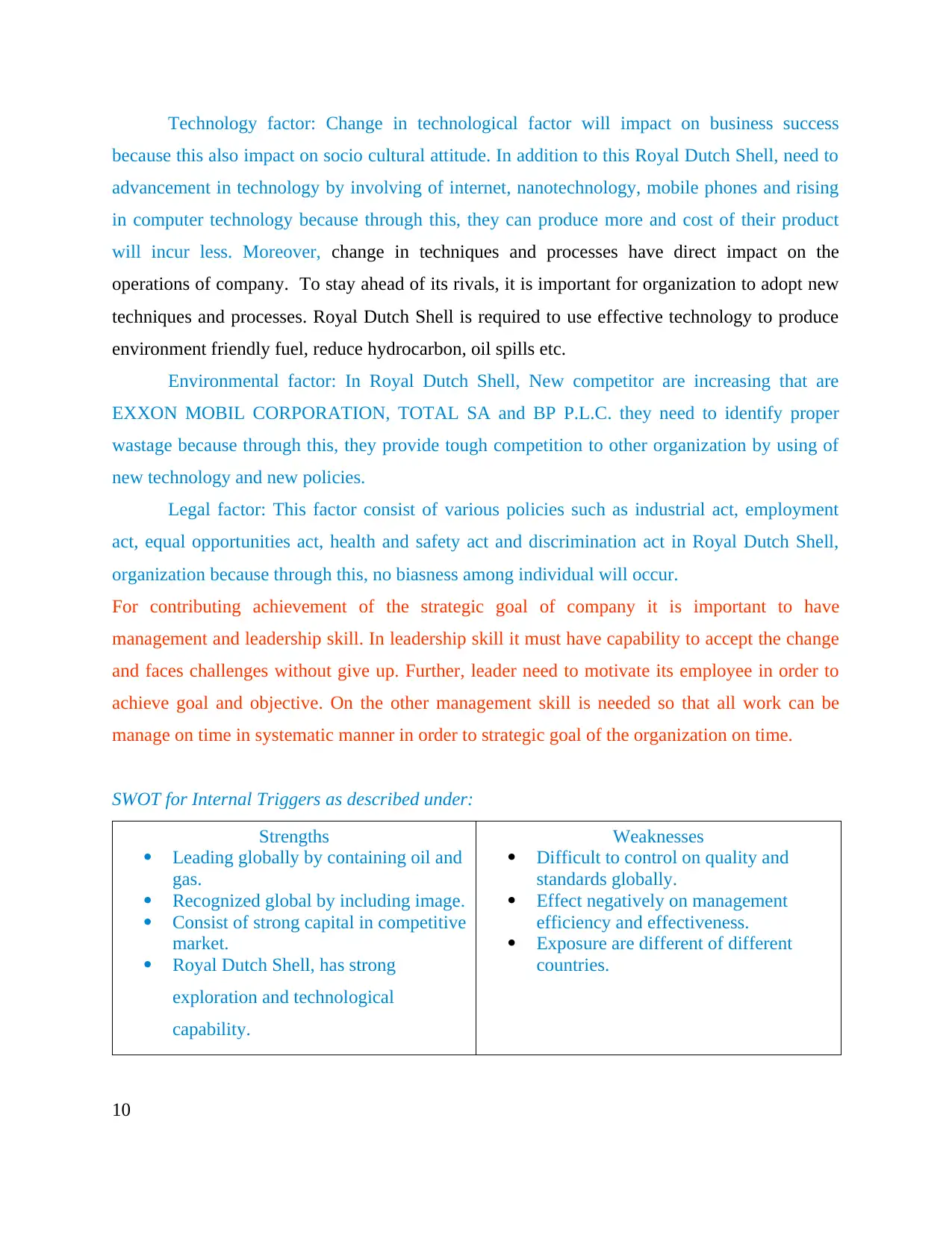
Technology factor: Change in technological factor will impact on business success
because this also impact on socio cultural attitude. In addition to this Royal Dutch Shell, need to
advancement in technology by involving of internet, nanotechnology, mobile phones and rising
in computer technology because through this, they can produce more and cost of their product
will incur less. Moreover, change in techniques and processes have direct impact on the
operations of company. To stay ahead of its rivals, it is important for organization to adopt new
techniques and processes. Royal Dutch Shell is required to use effective technology to produce
environment friendly fuel, reduce hydrocarbon, oil spills etc.
Environmental factor: In Royal Dutch Shell, New competitor are increasing that are
EXXON MOBIL CORPORATION, TOTAL SA and BP P.L.C. they need to identify proper
wastage because through this, they provide tough competition to other organization by using of
new technology and new policies.
Legal factor: This factor consist of various policies such as industrial act, employment
act, equal opportunities act, health and safety act and discrimination act in Royal Dutch Shell,
organization because through this, no biasness among individual will occur.
For contributing achievement of the strategic goal of company it is important to have
management and leadership skill. In leadership skill it must have capability to accept the change
and faces challenges without give up. Further, leader need to motivate its employee in order to
achieve goal and objective. On the other management skill is needed so that all work can be
manage on time in systematic manner in order to strategic goal of the organization on time.
SWOT for Internal Triggers as described under:
Strengths
Leading globally by containing oil and
gas.
Recognized global by including image.
Consist of strong capital in competitive
market.
Royal Dutch Shell, has strong
exploration and technological
capability.
Weaknesses
Difficult to control on quality and
standards globally.
Effect negatively on management
efficiency and effectiveness.
Exposure are different of different
countries.
10
because this also impact on socio cultural attitude. In addition to this Royal Dutch Shell, need to
advancement in technology by involving of internet, nanotechnology, mobile phones and rising
in computer technology because through this, they can produce more and cost of their product
will incur less. Moreover, change in techniques and processes have direct impact on the
operations of company. To stay ahead of its rivals, it is important for organization to adopt new
techniques and processes. Royal Dutch Shell is required to use effective technology to produce
environment friendly fuel, reduce hydrocarbon, oil spills etc.
Environmental factor: In Royal Dutch Shell, New competitor are increasing that are
EXXON MOBIL CORPORATION, TOTAL SA and BP P.L.C. they need to identify proper
wastage because through this, they provide tough competition to other organization by using of
new technology and new policies.
Legal factor: This factor consist of various policies such as industrial act, employment
act, equal opportunities act, health and safety act and discrimination act in Royal Dutch Shell,
organization because through this, no biasness among individual will occur.
For contributing achievement of the strategic goal of company it is important to have
management and leadership skill. In leadership skill it must have capability to accept the change
and faces challenges without give up. Further, leader need to motivate its employee in order to
achieve goal and objective. On the other management skill is needed so that all work can be
manage on time in systematic manner in order to strategic goal of the organization on time.
SWOT for Internal Triggers as described under:
Strengths
Leading globally by containing oil and
gas.
Recognized global by including image.
Consist of strong capital in competitive
market.
Royal Dutch Shell, has strong
exploration and technological
capability.
Weaknesses
Difficult to control on quality and
standards globally.
Effect negatively on management
efficiency and effectiveness.
Exposure are different of different
countries.
10
Paraphrase This Document
Need a fresh take? Get an instant paraphrase of this document with our AI Paraphraser
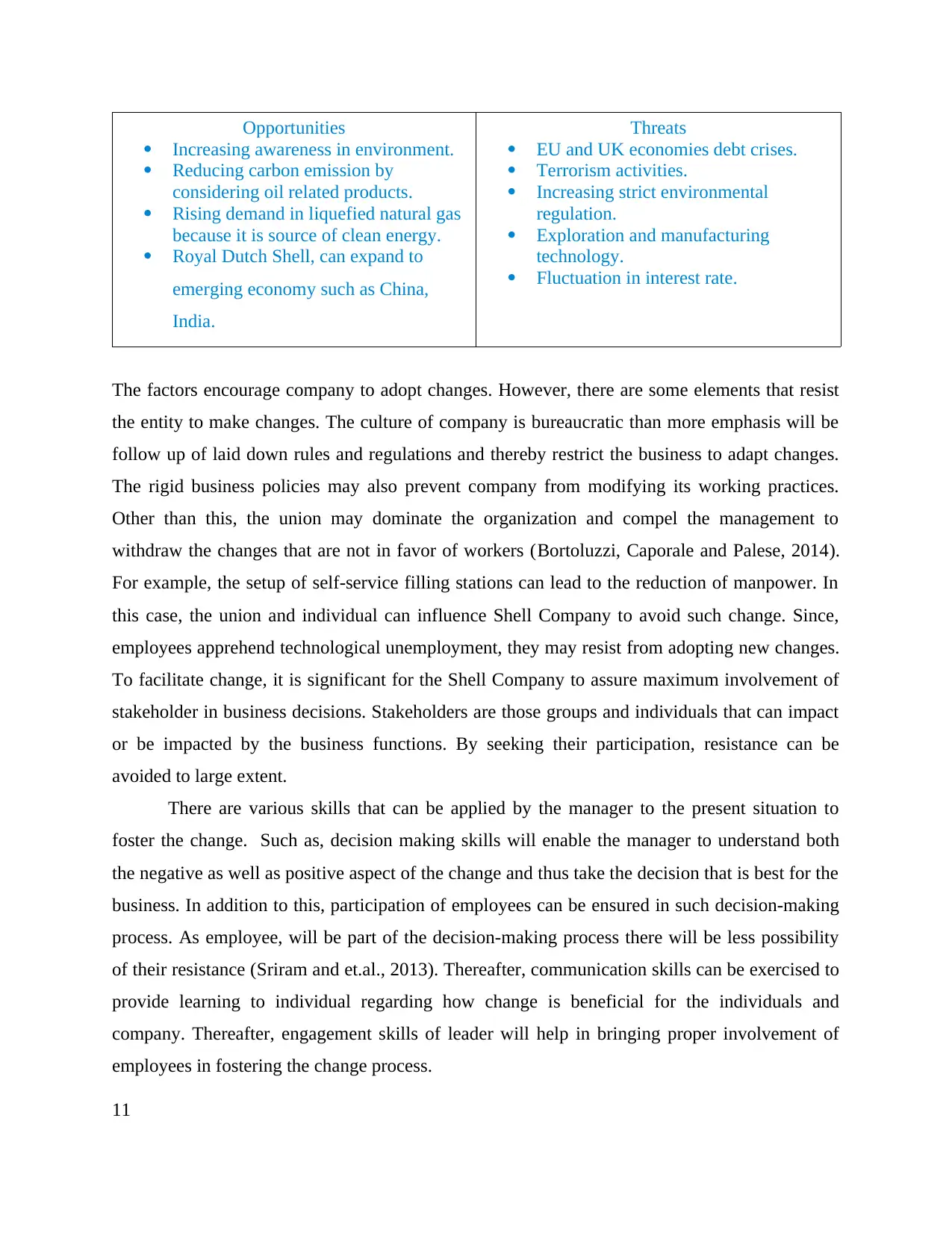
Opportunities
Increasing awareness in environment.
Reducing carbon emission by
considering oil related products.
Rising demand in liquefied natural gas
because it is source of clean energy.
Royal Dutch Shell, can expand to
emerging economy such as China,
India.
Threats
EU and UK economies debt crises.
Terrorism activities.
Increasing strict environmental
regulation.
Exploration and manufacturing
technology.
Fluctuation in interest rate.
The factors encourage company to adopt changes. However, there are some elements that resist
the entity to make changes. The culture of company is bureaucratic than more emphasis will be
follow up of laid down rules and regulations and thereby restrict the business to adapt changes.
The rigid business policies may also prevent company from modifying its working practices.
Other than this, the union may dominate the organization and compel the management to
withdraw the changes that are not in favor of workers (Bortoluzzi, Caporale and Palese, 2014).
For example, the setup of self-service filling stations can lead to the reduction of manpower. In
this case, the union and individual can influence Shell Company to avoid such change. Since,
employees apprehend technological unemployment, they may resist from adopting new changes.
To facilitate change, it is significant for the Shell Company to assure maximum involvement of
stakeholder in business decisions. Stakeholders are those groups and individuals that can impact
or be impacted by the business functions. By seeking their participation, resistance can be
avoided to large extent.
There are various skills that can be applied by the manager to the present situation to
foster the change. Such as, decision making skills will enable the manager to understand both
the negative as well as positive aspect of the change and thus take the decision that is best for the
business. In addition to this, participation of employees can be ensured in such decision-making
process. As employee, will be part of the decision-making process there will be less possibility
of their resistance (Sriram and et.al., 2013). Thereafter, communication skills can be exercised to
provide learning to individual regarding how change is beneficial for the individuals and
company. Thereafter, engagement skills of leader will help in bringing proper involvement of
employees in fostering the change process.
11
Increasing awareness in environment.
Reducing carbon emission by
considering oil related products.
Rising demand in liquefied natural gas
because it is source of clean energy.
Royal Dutch Shell, can expand to
emerging economy such as China,
India.
Threats
EU and UK economies debt crises.
Terrorism activities.
Increasing strict environmental
regulation.
Exploration and manufacturing
technology.
Fluctuation in interest rate.
The factors encourage company to adopt changes. However, there are some elements that resist
the entity to make changes. The culture of company is bureaucratic than more emphasis will be
follow up of laid down rules and regulations and thereby restrict the business to adapt changes.
The rigid business policies may also prevent company from modifying its working practices.
Other than this, the union may dominate the organization and compel the management to
withdraw the changes that are not in favor of workers (Bortoluzzi, Caporale and Palese, 2014).
For example, the setup of self-service filling stations can lead to the reduction of manpower. In
this case, the union and individual can influence Shell Company to avoid such change. Since,
employees apprehend technological unemployment, they may resist from adopting new changes.
To facilitate change, it is significant for the Shell Company to assure maximum involvement of
stakeholder in business decisions. Stakeholders are those groups and individuals that can impact
or be impacted by the business functions. By seeking their participation, resistance can be
avoided to large extent.
There are various skills that can be applied by the manager to the present situation to
foster the change. Such as, decision making skills will enable the manager to understand both
the negative as well as positive aspect of the change and thus take the decision that is best for the
business. In addition to this, participation of employees can be ensured in such decision-making
process. As employee, will be part of the decision-making process there will be less possibility
of their resistance (Sriram and et.al., 2013). Thereafter, communication skills can be exercised to
provide learning to individual regarding how change is beneficial for the individuals and
company. Thereafter, engagement skills of leader will help in bringing proper involvement of
employees in fostering the change process.
11
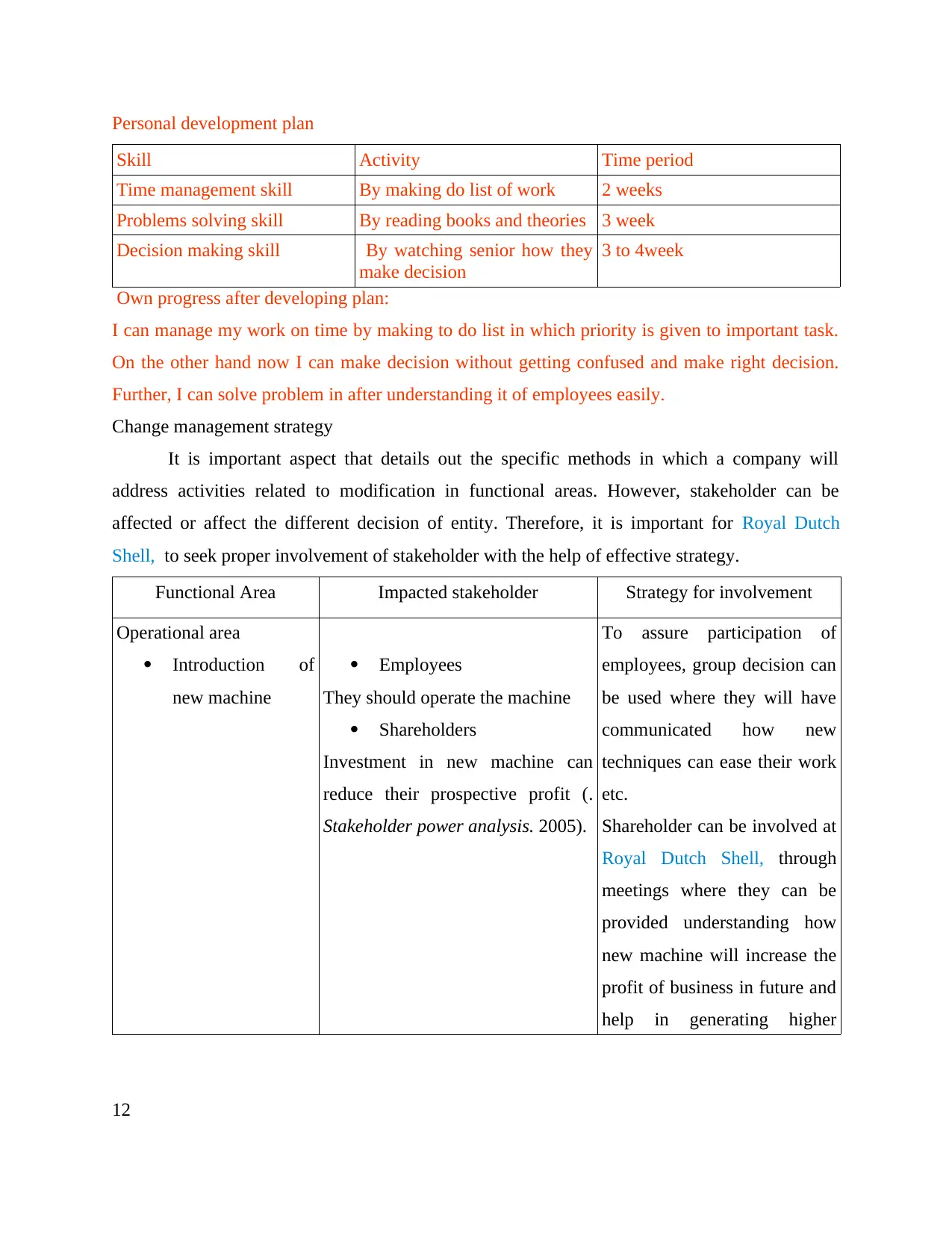
Personal development plan
Skill Activity Time period
Time management skill By making do list of work 2 weeks
Problems solving skill By reading books and theories 3 week
Decision making skill By watching senior how they
make decision
3 to 4week
Own progress after developing plan:
I can manage my work on time by making to do list in which priority is given to important task.
On the other hand now I can make decision without getting confused and make right decision.
Further, I can solve problem in after understanding it of employees easily.
Change management strategy
It is important aspect that details out the specific methods in which a company will
address activities related to modification in functional areas. However, stakeholder can be
affected or affect the different decision of entity. Therefore, it is important for Royal Dutch
Shell, to seek proper involvement of stakeholder with the help of effective strategy.
Functional Area Impacted stakeholder Strategy for involvement
Operational area
Introduction of
new machine
Employees
They should operate the machine
Shareholders
Investment in new machine can
reduce their prospective profit (.
Stakeholder power analysis. 2005).
To assure participation of
employees, group decision can
be used where they will have
communicated how new
techniques can ease their work
etc.
Shareholder can be involved at
Royal Dutch Shell, through
meetings where they can be
provided understanding how
new machine will increase the
profit of business in future and
help in generating higher
12
Skill Activity Time period
Time management skill By making do list of work 2 weeks
Problems solving skill By reading books and theories 3 week
Decision making skill By watching senior how they
make decision
3 to 4week
Own progress after developing plan:
I can manage my work on time by making to do list in which priority is given to important task.
On the other hand now I can make decision without getting confused and make right decision.
Further, I can solve problem in after understanding it of employees easily.
Change management strategy
It is important aspect that details out the specific methods in which a company will
address activities related to modification in functional areas. However, stakeholder can be
affected or affect the different decision of entity. Therefore, it is important for Royal Dutch
Shell, to seek proper involvement of stakeholder with the help of effective strategy.
Functional Area Impacted stakeholder Strategy for involvement
Operational area
Introduction of
new machine
Employees
They should operate the machine
Shareholders
Investment in new machine can
reduce their prospective profit (.
Stakeholder power analysis. 2005).
To assure participation of
employees, group decision can
be used where they will have
communicated how new
techniques can ease their work
etc.
Shareholder can be involved at
Royal Dutch Shell, through
meetings where they can be
provided understanding how
new machine will increase the
profit of business in future and
help in generating higher
12
⊘ This is a preview!⊘
Do you want full access?
Subscribe today to unlock all pages.

Trusted by 1+ million students worldwide
1 out of 31
Related Documents
Your All-in-One AI-Powered Toolkit for Academic Success.
+13062052269
info@desklib.com
Available 24*7 on WhatsApp / Email
![[object Object]](/_next/static/media/star-bottom.7253800d.svg)
Unlock your academic potential
Copyright © 2020–2025 A2Z Services. All Rights Reserved. Developed and managed by ZUCOL.





